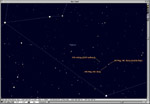WEEKLY UPDATE FOR 12 AUGUST 2005:
GRAVITY PROBE B MISSION STATUS AT A GLANCE

| Item | Current Status |
| Mission Elapsed Time | 479 days (68 weeks/1.31. years) |
| Science Data Collection | 350 days (51 weeks/11.51 months) |
| Current Orbit # | 7,006 as of 1:00 PM PST |
| Spacecraft General Health | Good |
| Roll Rate | Normal at 0.7742 rpm (77.5 seconds per revolution) |
| Gyro Suspension System (GSS) | All 4 gyros digitally suspended in science mode |
| Dewar Temperature | 1.82 kelvin, holding steady |
| Global Positioning System (GPS) lock | Greater than 96.7% |
| Attitude & Translation Control (ATC) | X-axis attitude error: 144.1 marcs rms |
| Command & Data Handling (CDH) | B-side (backup) computer in control Multi-bit errors (MBE): 0 Single-bit errors (SBE): 7 (daily average) |
| Telescope Readout (TRE) | Nominal |
| SQUID Readouts (SRE) | Nominal |
| Gyro #1 rotor potential | -0.7 mV |
| Gyro #2 rotor potential | +1.6 mV |
| Gyro #3 rotor potential | -2.6 mV |
| Gyro #4 rotor potential | -0.5 mV |
| Gyro #1 Drag-free Status | Backup Drag-free mode (normal) |
MISSION DIRECTOR'S SUMMARY
As of Mission Day 479, the Gravity Probe B vehicle and payload are in good health. All four gyros are digitally suspended in science mode. The spacecraft is flying drag-free around Gyro #1.

With nearly a full year of science data captured, the mission is proceeding well. This past week, we made some routine adjustments during our final week of nominal science data collection. These adjustments included updating the star tracker star magnitudes, running an SRE calibration (SQUID Readout Electronics), updating the control gyro z-bias, and power cycling the ECU (Electronics Control Unit).


On Monday, August 15th, we will begin the final calibration phase of the mission. In this phase, we will be maneuvering the spacecraft to nearby stars and then back to the guide star to calibrate the Gyroscope Suspension System (GSS). This phase will last two weeks, ending around August 29th. If any helium remains, further calibrations will be performed at a different vehicle roll rate. Because of the nature of these calibrations, the science (data gathering) phase of the mission will end as soon as we begin these calibrations. By that point, we will have collected 352 days (or 11.5 months) of science data--a great success!
Note: During this final calibration phase, our weekly updates will be limited to the Mission Director's Summary, as our communications and public affairs team members will be concentrating their efforts on our End-of-Mission activities and our final report to NASA.
UPDATED NASA/GP-B FACT SHEET AVAILABLE FOR DOWNLOADING
We recently updated our NASA Factsheet on the GP-B mission and experiment. You'll now find this 6-page document (Adobe Acrobat PDF format) listed as the last navigation link under "What is GP-B" in the upper left corner of this Web page. You can also click here to download a copy.
Drawings & Photos: The layered composite photo of the GP-B spacecraft orbiting the Earth was created by GP-B Public Affairs Coordinator, Bob Kahn using Adobe Photoshop and Adobe Illustrator. Mr. Kahn also took the photo of the GP-B Mission Operations Center in action. The sky chart images, showing the constellation Pegasus, in which the guide star, IM Pegasi resides, were generated by the Voyager III Sky Simulator from Carina Software. Click on the thumbnails to view these images at full size.
MORE LINKS ON RECENT TOPICS
- Track the satellite in the sky
- Photo, video & and news links
- Build a paper model of the GP-B Spacecraft
- Following the mission online
- Our mailing list—receive the weekly highlights via email
- The GP-B Launch Companion in Adobe Acrobat PDF format. Please note: this file is 1.6 MB, so it may take awhile to download if you have a slow Internet connection.
Previous Highlight
Index of Highlights
